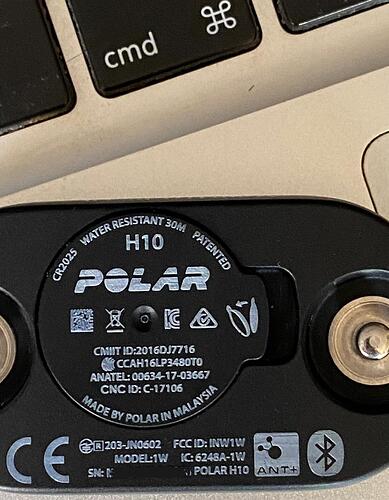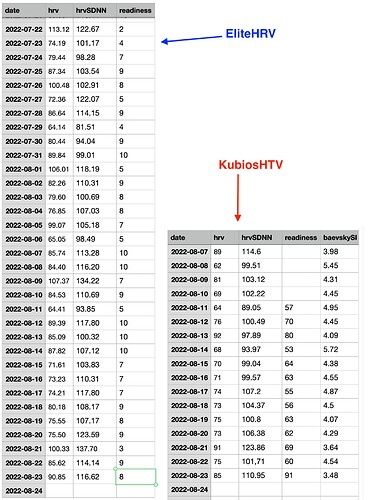I also bought mine in February, and it’s on 80% from 130 hours use. Strange that you say a 2035 battery, as the manual and battery cover shows 2025.
my mistake… it’s a 2025 . havent changed the batt since I got it in the mail.
Mine doesnt show up using BLE Hero. But my Stryd does. (The Stryd never turns off. never)
Halleluja! As of this week I see HRV-rmssd values coming in from my Garmin Fenix 7. I assume it has to do with the new Alpha firmware I installed last weekend.
Anyways, makes me real happy. Now I can monitor and baseline my HRV daily values.
Excellent!
The only problem with disconnecting it each time that I have come across is that over time the button(s) may break if your not careful removing it each time. Luckily you can buy a replacement strap.
Me too since Monday on my 955, so I guess David has enabled it!
Hi. First of all, I read all the topic, because HRV is something that I’m very interested of.
I bought Polar H6 in 2013 and I used it to measure my HRV with EliteHRV. After a while the strap stopped working and I stopped using EliteHRV.
In October 2020 I bought HRM Pro from Garmin, because my main sport is running and considering it has running metrics I thought it should be good to understand the running mechanics better.
I’ve been training in MAF method since the end of 2019 and in the last 3 months I’ve been adding one interval training or a tempo run a week, trying to do 80/20.
I’ve been using HRV since november 2020 to track my health and recovery.
Questions:
-
What do you think about Garmin Strap? Do you think it is comparable with Polar H10?
-
And about apps to track HRV, what app do you think is more trustable to measure HRV? I’m using Kubios and EliteHRV and they have different results. I know I shouldn’t compare two different apps, but which one is more precise?
I also suggest, as told before, to separate morning HRV and DFA Alpha 1 in two different topics.
@david would it be possible to set “EPOC” on the Fitness page, so you can put it in context with power or heartrate over time? Thanks.
Regarding your questions:
- I had pretty good morning HRV results with Kubios + Garmin Dual HRM. No experience with HRM Pro. I haven’t seen any noticeable difference when switching to Polar H10.
- Polar H10 has the possibility to record ECG. I don’t think the Garmin’s can. The HRM dual for sure can’t. And that is important if you consider doing something with ECG. Fatmaxxer and now Fitness HRV are using the ECG signal.
- What are you comparing when testing different apps? Are you comparing RMSSD values (which should be very similar), or are you comparing Readiness (which you shouldn’t even bother recording)? I would be surprised if there were noticeable differences in RMSSD when using Elite, HRV4Training or Kubios. These are all top class apps, using the recommended filtering and artefact rejection. When it comes to the Readiness score, it’s a different story. HRV4Training and Elite have an interpretation that also considers your subjective scoring. Kubios is not taking that in account.
There have been updates to the Fitness HRV PC app making it work with most off the ANT dongles and devices. Latest version has a tab to configure what will or won´t be used as a source.
Thanks! Time to give it another try then.
I asked Marco what did he think about HRM Pro comparing to Polar H10 and he said both are equivalent.
I’m comparing RMSSD and SDNN. I measured it simultaneously.The average HR and the graphic in both apps are the same. I imagined maybe they are treating artifacts differently.
I started to use Kubios because it has Baevsky Stress Index, ant it would complement my data.
What exactly did you do to measure simultaneously?
2 phones, 2 apps and 2 straps or 2 phones,2 apps, 1 strap or maybe even 1 phone, 2 apps, 1 strap?
And just to be 100% sure: these are the RAW rMSSD and SDNN values?
Trend looks very similar and that’s the most important, but nevertheless, I would expect the values to be almost identical…
One thing that differs in between the apps is the HR by which they switch from 0.05 (rest) to 0.20 (active) as artefact threshold. In your case probably not important at all because the chosen HR is somewhere in between 70 and 100. Your RHR is likely way lower when I see your HRV scores.
Kubios is not very informative when it comes to the phone app. Elite says they use the Kubios Premium method. Difficult to say where the differences are coming from.
Elite uses 2*Ln(rMSSD) as readiness and complements with subjective socres.
I’m using 1 phone, 2 apps, 1 strap and I do the measure simultaneously.
But I think the values are a little different. Some days they are identical and another very different. That’s why I think one of them are not correct, because I think the trend is different.
That’s my today’s morning measure. As shown, the average HR is identical (and always is the same). And the graphic seems to be the same, just inverted, because Kubios shows R-R Intervals and EliteHRV shows his own mathematic method.
So would that be the average EPOC for each activity?
Yes i think, so you can see for example average power/epoc over time 🤷🏼
I think its peak EPOC
I stopped using HRV4 and Elite and stuck with Kubios as I just couldn’t trust their subjective scores - there just seemed to be no transparency. That’s why I started using the intervals.icu ‘wellness’ page/s.
I also used the Kubios desktop app for a while but (as yet) I haven’t taken the time to (find out how to) transmit the kubios app info to it. Previously I exported from Elite/HRV4 and imported from there, but that was a pain.
A nice article from Marco (HRV4Training) explaining about overnight HRV:
The hrv4training score is a logarithmic conversion, you also have the option to see the rMSSD value not only this conversion.


